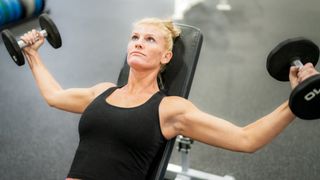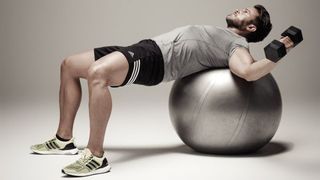How To Do Dumbbell Flyes Correctly And Build A Bigger Chest
Learn how to do dumbbell flyes properly and your pecs will get a thorough workout

So building a bigger chest is on your agenda. That’s fair enough. The same can be said for many of us who regularly hit the gym. But before you make a beeline for the bench press, understand that there is another way to strengthen your chest and promote new growth in the pecs. That way is via the often-overlooked dumbbell flye.
The dumbbell flye targets all areas of the pecs, but most significantly the sternal fibers—those that attach directly to your sternum. Growth in this particular region creates the defined chest separation look associated with all your muscle-bound heroes.
The move is also better at stimulating pectoral growth than the flat bench press. What’s more, you don’t have to lift anywhere near as heavy, and since there’s almost always a wait for bench press stations at the gym during busy times of the day, this offers a viable alternative when time is of the essence.
Despite its long list of benefits, it’s also an exercise that’s commonly misunderstood. To make sure your immaculate form is the talk of the gym, we’ve spoken to strength and conditioning coach Ryan Horton of Horton Barbell.
Here you’ll find his expert how-to guide to master proper dumbbell flye form, along with common pitfalls to avoid and his rule on when you should deploy this chest exercise and when you should stick to the bench press.
How To Do The Dumbbell Flye
To do this move, you need a pair of dumbbells and a flat weight bench, or one set at a very slight incline.
The Set-Up
Sit on one end of a bench with the dumbbells resting on your thighs. “Lie back, using your legs to help ‘pop’ the dumbbells to your chest, then press them straight up over your chest,” says Horton.
Get the Coach Newsletter
Sign up for workout ideas, training advice, reviews of the latest gear and more.
The Lower
“Turn your wrists so your palms face each other over the top of your chest. There should be a slight bend in your elbow,” says Horton. “From here, lower the dumbbells out to your sides until they are level with your torso.”
The Return
Once you feel a gentle stretch in your pecs, while you maintain a slight bend in your elbows, you’ve reached the lowest point of the lift. “When you reach this point, squeeze and contract your pecs to bring your arms back to the starting position over the top of the chest,” says Horton.
Dumbbell Flye Form Tips

Avoid the arch
You may see elite-level powerlifters arch their back when performing chest exercises like the bench press. Don’t attempt to emulate them—remember that the goal of powerlifting is moving a weight from A to B with sufficient force. Your goal is to recruit and target muscle fibres to elicit new growth.
Keep your elbows bent
Be sure not to straighten your arms fully and lock them out. This takes the emphasis off the pectoral muscle fibers and channels the load you are lifting into the elbow and shoulder joints. This increases injury risk and doesn’t activate the chest enough.
Don’t overstretch
Be careful not to let your elbows drop too low at the bottom of the rep. Overstretching during this part of the movement could injure your shoulders and reduce the amount of work the pec muscles do. Horton says you should go by feel because one person’s range of motion could be wildly different from another’s. “You’re looking for a slight stretch in the pec. Once you feel that, contract your muscles and bring the dumbbells back to the top of the lift.”
Benefits Of The Dumbbell Flye
The number one benefit of the dumbbell flye, over and above all other chest exercises, is muscle growth, explains Horton. However, it should be used wisely and rarely in isolation.
“The dumbbell flye is a good chest exercise to use towards the end of your upper-body workouts as a way to add volume and focus on hypertrophy for the pec muscles,” he says.
But if your goal is strength, power and dynamism for a particular sport, it should only be used as a supplementary exercise. “It’s more of what I consider a bodybuilding-type movement, rather than one to aid sports performance.”
Which muscles does the dumbbell flye work?
The dumbbell flye is a rarity. Unlike most pressing movements like the bench press or overhead press, it isn’t a compound exercise. Instead, it targets the chest almost exclusively.
“Because you’re not bending the elbow, all the movement is initiated at the chest,” says Horton. This completely bypasses the triceps, which are typically involved in pushing exercises. “You might feel a little bit of work on the anterior deltoid of the shoulders, but for the most part all of the emphasis is on the pec major and pec minor muscles of the chest.”
Dumbbell Bench Press Versus Dumbbell Flye
Which is better, the bench press or the dumbbell flye? This, says Horton, all depends on your goal. “For strength, for power, for functional fitness, I would always pick the dumbbell bench press,” he says. “But if you’re working on your physique, building mass, looking to add volume to your upper-body workouts, then the dumbbell flye is the one.”
That said, Horton doesn’t believe the two moves should be mutually exclusive. “The dumbbell flye is a great exercise to throw in after you’ve done your main movements for the day,” he says. “So after you’ve ticked off your bench and your incline bench.”
Because the dumbbell flye solely targets the pecs, it will lead to fatigue in those muscle groups quicker than when performing a compound move like the bench press. For that reason you’ll also need to lift considerably lighter.
Therefore, Horton adds, you should always kick off with the major mover—such as the bench—then round off your workout with a smaller isolation exercise like the dumbbell flye to ensure you’ve left no stone unturned in building a bigger, stronger, more robust pair of pecs.
Dumbbell Flye Variations
Incline dumbbell flye

The incline flye targets the top of the pecs more than the flat version of the exercise does and it’s the variation used in our gym-based chest workout plan. To do it, set your bench up at an incline of around 30°. Then lie back and perform the flye as you would with a flat bench, paying extra care not to overstretch when you bring the weights down.
Gym ball dumbbell flye

To make the dumbbell flye a heck of a lot harder and enlist all manner of other muscles in the movement, try performing the move while resting your back on a gym ball rather than a bench. Because you’re supporting your shoulders and back on an unstable surface, muscles all over your body have to work throughout the exercise to keep your body upright, which means you improve your balance and core strength on top of the chest-building benefits of the flye itself.
To perform this variation pick a lighter dumbbell than normal, then rest your shoulders and back on the top of a gym ball with your feet planted firmly on the ground.
About Our Expert
Ryan Horton is the owner of Horton Barbell. He began his career as a strength and conditioning coach in 2004, holding positions ranging from assistant coach to director of strength and conditioning at a number of US universities, including Temple University. Before opening Horton Barbell, he held the position of director of applied sports science with the Georgia Tech American football team. He graduated with a BA in exercise physiology from Otterbein University.

Joe Warner is a highly experienced journalist and editor who began working in fitness media in 2008. He has featured on the cover of Men’s Fitness UK twice and has co-authored Amazon best-sellers including 12-Week Body Plan. He was the editor of Men’s Fitness UK magazine between 2016 and 2019, when that title shared a website with Coach.
- Harry BullmoreStaff writer
